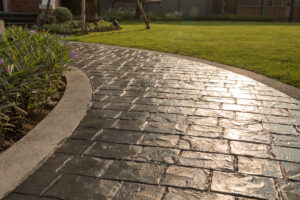
Continue reading to find out more about how moisture might collect behind the sealer, which could cause the membrane to get cloudy and leave behind a white residue. Then, call 310-944-9099 to speak with Fuller Stone Care about their expert concrete sealing services.
staying clear of problems during the application procedure
There are primarily two ways that moisture issues arise. The first is when moisture is in touch with the sealer as it is being applied. All cures, sealers, and cures and sealers are designed to withstand varied degrees of moisture interaction. Because cures, curs, and sealers can withstand more moisture, they can be used on concrete with a high moisture content (sometimes referred to as green concrete) without causing it to turn white or cloud over.
A decorative sealer, on the other hand, cannot tolerate any moisture at all. For this reason, we never use a decorative sealer before the concrete has had a minimum of 28 days to cure. You can expect that green concrete will ultimately develop a white haze if ornamental sealer is sprayed to it. Everything here has to do with the coating’s base resin and how it reacts to contact with moisture.
Utilize a superior sealant
When the sealer is overly permeable, moisture issues can arise in a second method. This essentially means that water can easily pass through the membrane. The type, thickness, and content of the solids will all affect how permeable the sealer is.
Each external acrylic cure, cure and seal, and sealer, for instance, is intended to allow for a certain level of permeability when applied to 300–500 square feet per gallon. More moisture will pass through the sealer without being stuck and subsequently turning white the lower the solid content or thinner the membrane thickness.
For this reason, it’s important to use the proper sealant and apply it with the appropriate thickness. This is particularly true when working with high-solids-content products, or those that include more than 25% solids. The lesser your margin of error, the higher the solids content. Overusing high-solids cures, seals, or sealers is typically the root of moisture-related problems with sealers.
Entrust the task to the pros to avoid moisture
Now that you know what can result in concrete that has been colored and sealed being damaged by moisture. Remember that hiring specialists to complete these tasks for you results in a much superior outcome, even though doing it yourself may save you money in the short term. In the long run, this can help you. Call Fuller Stone Care at 310-944-9099 for a estimate and to discuss your alternatives and costs.
